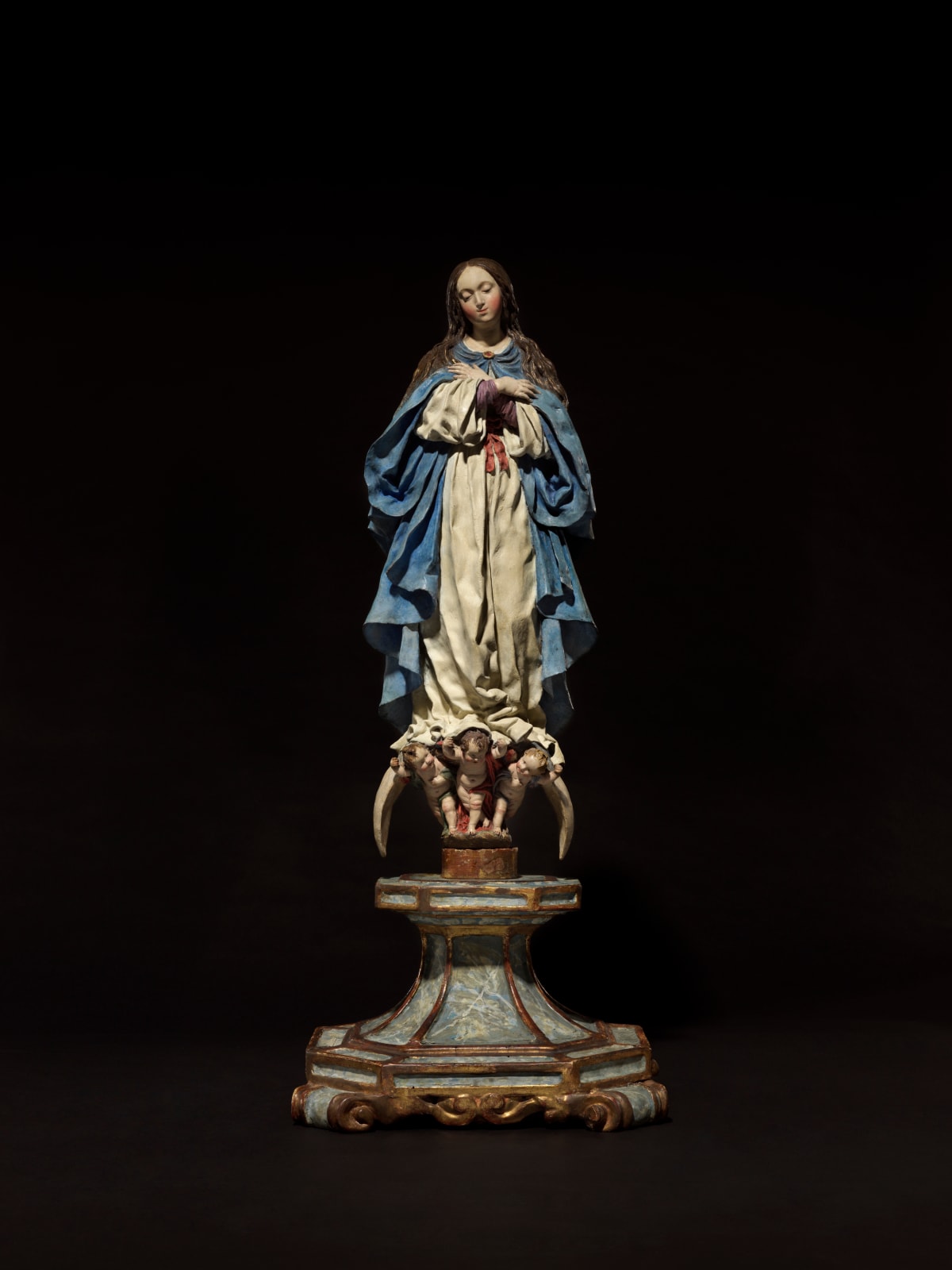-







LUISA ROLDAN, CALLED LA ROLDANA
Virgin of the Immaculate Conception, c. 1690-1706Terracotta, polychromed; on an octagonal parcel-gilt, polychrome wood base with scrolling feet52 cm (20 ½ in.) high
73.7 cm (29 in.) high, overallFurther images
Provenance
Private collection;
With Coll and Cortés, 2016;Private collection, Austria.
Literature
Luisa Roldán: Court Sculptor to the Kings of Spain. Madrid: Coll & Cortes 2016, pp. 46, 48, reproduced p. 53, fig 36.
Hall van den Elsen, Catherine. 2018. Fuerza e intimismo: Luisa Roldán, escultora (1652-1706). Madrid: Consejo Superior de Investigaciones Científicas 2018, pp. 148-49.
Related literature
Alcazar 1614
Alcazar, Luis de. 1614. Rev. Patris Ludovici ab Alcasar, Hispalensis e Societate Jesu Theologi, & in provincia bætica sacræ scripturæ professoris, Vestigatio arcani sensus in Apocalypsi. Antwerp: apud Joannem Keerbergium : typis Gerardi Wolschati, & Henrici Ærtsi.Barrios Aguilera 2011
Barrios Aguilera, Manuel. 2011. La invención de los libros plúmbeos: Fraude, historia y mito. Granada: Editorial Universidad de Granada.Coll & Cortés 2016
Luisa Roldán Court Sculptor to the Kings of Spain. Madrid: Coll & Cortes.Domínguez Matito 2007
Domínguez Matito, Francisco. 2007. “Un auto sacramental en su contexto: El hereje de Álvaro Cubillo de Aragón.” eHumanista: 241-69.Domínguez Matito 2018
Domínguez Matito, Francisco. 2018. “Escenografía para La hidalga del valle: un auto a la sazón.” Anuario Calderoniano: 63–80.Góngora 2019
Góngora, Luis de. 2019. Sonetos. Ed. Juan Matas Caballero. Madrid: Cátedra.González Tornel 2021
González Tornel, Pablo. 2021. Ver es creer: la Inmaculada Concepción y España en el siglo XVII. Madrid: Consejo Superior de Investigaciones Científicas.Hall-van den Elsen 2018
Hall van den Elsen, Catherine. 2018. Fuerza e intimismo: Luisa Roldán, escultora (1652-1706). Madrid: Consejo Superior de Investigaciones Científicas.Hall-van den Elsen 2021
Hall-van den Elsen, Catherine. Luisa Roldán. London: Lund Humphries.Hall-van den Elsen 2024
Hall-van den Elsen, Catherine. 2024. Gender and the Woman Artist in Early Modern Iberia. New York and London: Routledge.Heredia Barnuevo 1741
Heredia Barnuevo, Diego Nicolás de. 1741. Mystico ramillete histórico, chronológico panegirico. Granada: Imprenta Real.Howe 1986
Howe, Elizabeth Teresa. 1986. “Lope de Vega and the Immaculate Conception.” Bulletin of the Comediantes, Volume 38, Number 1: 39-53.Lenaghan 2016
Lenaghan, Patrick. 2016. “Luisa Roldán’s Career in Madrid: Intimate Masterpieces in Terracotta.” In Luisa Roldán Court Sculptor to the Kings of Spain, 20–41. Madrid: Coll & Cortes.Lenaghan 2020
Lenaghan, Patrick. 2020. “Luisa Roldán’s Virgin of Solitude (Virgen de la Soledad): Art and Religion in Madrid.” Bulletin of the Detroit Institute of Arts 94: 55–73.Lenaghan Forthcoming.
Lenaghan, Patrick. Forthcoming. “Caída y auge de Luisa Roldán en el mundo anglosajón.” In Luisa Roldán. Escultora Real. Valladolid: Museo Nacional de Escultura.Pacheco 1649
Pacheco, Francisco de. 1649. Arte de la pintura. Su antiguedad y grandezas. Seville: Simón Fajardo.Ruano de la Haza 1996
Ruano de la Haza, José María. 1996. “Historias de los textos dramáticos en el siglo de oro: Calderón, Las órdenes militares y la Inquisición” In Actas del IV Congreso Internacional de la Asociación Internacional Siglo de Oro (AISO), María Cruz García de Enterría and Alicia Cordón Mesa (editors), 75–93. Alcalá de Henares: Universidad de Alcalá de Henares.Stratton 1994
Stratton, Suzanne L. 1994. The Immaculate Conception in Spanish Art. Cambridge and New York: Cambridge University Press.Valdenebro y Cisneros 1889
Valdenebro y Cisneros, José M. de. 1889. Justa poética celebrada en la Parroquia de San Andrés de Córdoba el dia 15 de Enero de 1617. Seville: C. de Torres.Vizuete Mendoza 2005
Vizuete Mendoza, J. Carlos. 2005. “Voto, juramento y fiesta de la Inmaculada en la Universidad de Toledo,” 327–60. In La Inmaculada Concepción en España: religiosidad, historia y arte t.1. San Lorenzo del Escorial, Publicaciones del Real Centro Universitario Escorial-María Cristina, Ediciones Escurialenses.













